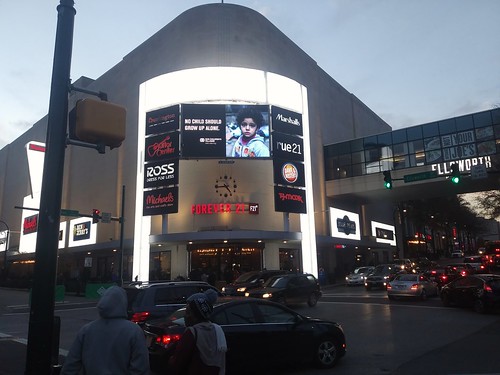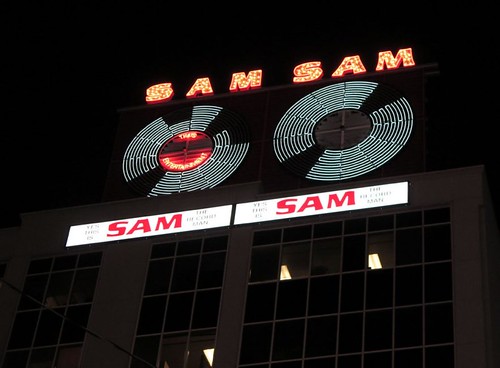Signs and marquees as public art and landmarks
I am a fan of outdoor signage as an urban design element of commercial districts and communities more generally. Although some quarters, such as the group Scenic America, look at most forms of outdoor advertising as a desecration of the public space.
Sure, places like Times Square in New York City, Piccadilly Circus in London ("Advertisers set to fight to have their name in lights at Piccadilly Circus," London Evening Standard), or sign-marked urban arterials in many cities can be somewhat cacophonous, but they also acknowledge, even celebrate commercialism in the context of the buoyant capitalism that marks the United States as the USA.
In DC, there is some billboard signage around Gallery Place and the Capital One Arena but it pales vis a vis NYC. The Downtown Silver Spring district in Montgomery County has developed a kind of Times Square effect, on a much smaller scale, with signage on one shopping center complemented by the neon signage of the cinemas across the street.

The Downtown Silver Spring night time signage is more bright than it is an artistic and aesthetic element of the streetscape.
Three recent sign type projects, although one is in Canada, are noteworthy, as they involved serious historic preservation and restoration efforts.
Two wrinkles with signs are (1) the old signs -- neon and electric -- tend to be more novel, but as other forms of advertising supplanted place-based advertising (signs and billboards), these types of signage fell out of use generally, replaced by back lit signs originally and now digital signs, and specifically, as companies went out of business; (2) defunct companies matter in terms of maintaining signage not only because they were motivated and successors are not, but because building regulations typically require the removal of the signs of defunct businesses regardless of the artistic and historic merits.
1. The Toronto Star reports ("Sam the Record Man sign lights up Yonge Dundas Square") that the sign advertising the original location of Sam the Record Man has been restored, after being out of commission for more than 10 years.

Jaren Kern, Toronto Star.
2. The Los Angeles Times reports ("Rare vintage electric sign lights up Sunset Boulevard again after a restoration") about the restoration of the Jensen's Recreation Center moving sign, which shows a bowler throwing strikes. From the article:
Considered groundbreaking technology at the time of its installation, the sign is controlled by a series of electric motors that switch the 1,300 red, green and white light bulbs on and off to give the appearance of movement.
The sign was mostly dark for about 50 years but has just been restored by new owners Vista Investment Group. ...
Animated incandescent signs predated neon signs, which became popular in the 1920s, said Eric Evavold, former board member of the Museum of Neon Art in Glendale. The Jensen’s sign is one of the largest such vintage, operable signs left in the world, he said.
“It’s incredible that this sign was just sitting there in the middle of the city for so long,” Evavold said. “This is a special jewel in our illuminated sign history.”
3. In Ann Arbor, the owners of the State Theatre building -- the top is still used for events, the bottom of the building has long been rented out as a separate retail space -- have restored the marquee ("Ann Arbor's newly restored State Theatre marquee more dazzling than ever," Ann Arbor News) as part of an upgrade to the entire property. The State Theatre is where I saw movies like "Purple Rain."

The State Theatre's marquee was relit after a period of renovations in downtown Ann Arbor on Friday, December 1, 2017. The State Theatre will officially reopen on Friday, December 8. Hunter Dyke | The Ann Arbor News
For a long time the separate Michigan Theater has been a nonprofit, showing films, concerts, etc. for decades, while the State Theatre had generally owned by regional cinema chains.
At some point, the Michigan Theater Foundation also acquired the State Theatre. Since the buildings are located within a block of each other, this kind of joint operation (not unlike what the Playhouse Square Foundation does in Cleveland -- "PlayhouseSquare stars in its own real estate revival," Cleveland Plain Dealer) makes sense.
The Ann Arbor combination of the State Theatre with the Michigan Theater is an illustration of my point about BTMFBA ("BTMFBA: the best way to ward off artist or retail displacement is to buy the building"), if you want to control the space and retain it as an element of the network of a community's civic and cultural assets, most often you're going to have to buy it yourself.
By contrast, DC's Takoma Theatre is slated to become a clinic facility for Children's Hospital, when at one point it was the most intact extant neighborhood theater property remaining in DC.
Labels: commercial district revitalization planning, cultural planning, historic preservation, public art, signage, theater-cinema


0 Comments:
Post a Comment
<< Home